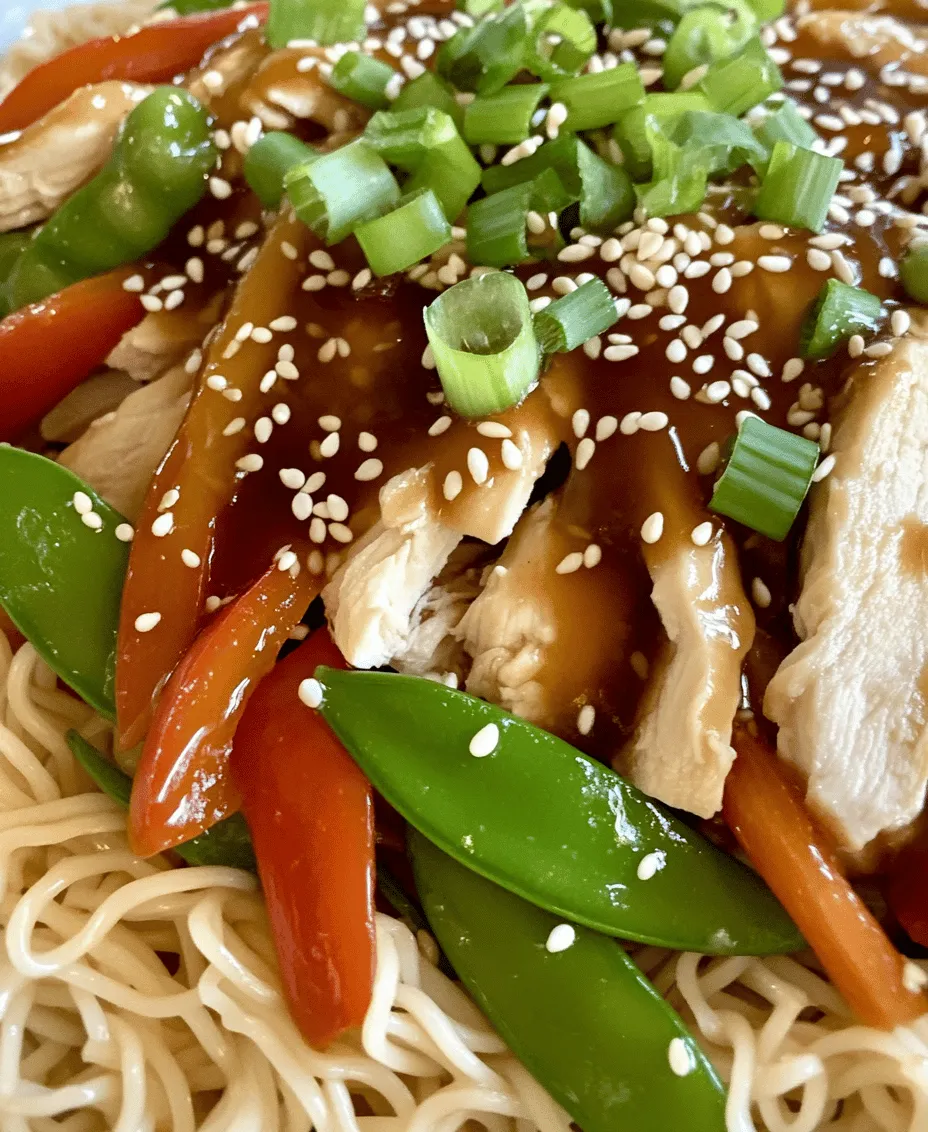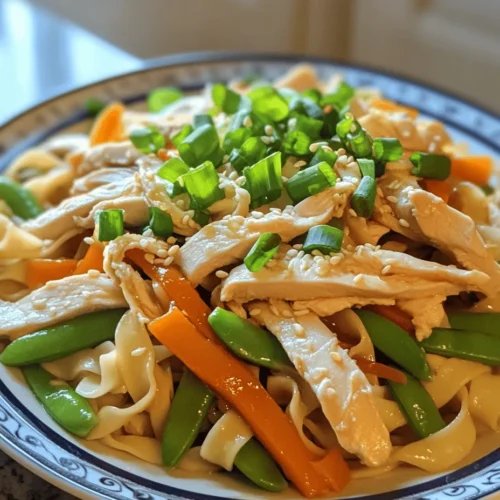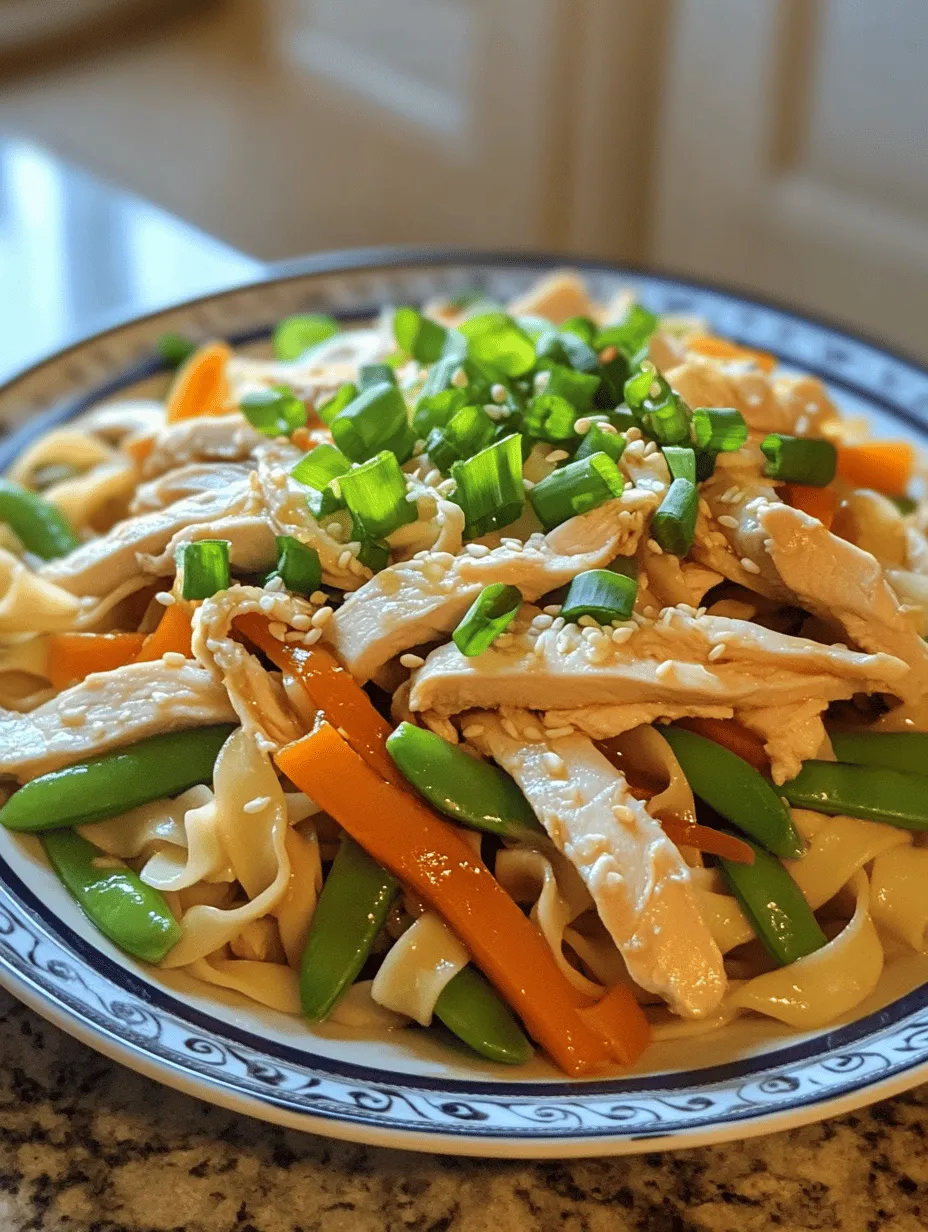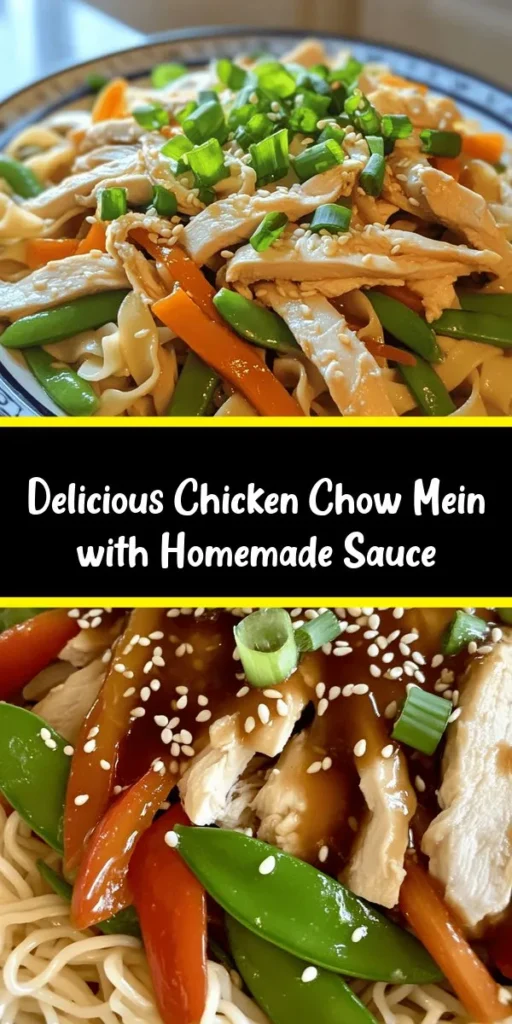Introduction
Chicken Chow Mein is a beloved dish that has graced tables around the world, celebrated for its comforting flavors and satisfying textures. Originating from Chinese cuisine, chow mein has become a staple in many households, particularly in Western countries, where it has been adapted to suit local tastes. What makes Chicken Chow Mein so appealing is not just its delicious flavor, but also the ease with which it can be prepared at home.
While takeout is convenient, nothing beats the freshness of a homemade dish. Making Chicken Chow Mein at home allows you to control the ingredients, ensuring that every bite is packed with flavor and nutrition. With this simple recipe, you will discover how to create a delightful Chicken Chow Mein that rivals your favorite restaurant version, featuring an easy-to-make sauce that elevates the dish to new heights.
Understanding Chicken Chow Mein
Chow Mein, which translates to “stir-fried noodles,” has a rich history that dates back centuries. This dish has its roots in Chinese cuisine, but as Chinese immigrants settled in various parts of the world, it underwent numerous adaptations. In the United States, for instance, chow mein can vary significantly from the traditional recipes found in China. Some versions include crispy noodles, while others feature softer, steamed options.
The essence of Chicken Chow Mein lies in its combination of stir-fried chicken, crunchy vegetables, and noodles, all brought together with a savory sauce. Notably, there are several variations of chow mein, including Cantonese-style and American-style, each boasting unique characteristics that reflect regional preferences.
From a nutritional standpoint, Chicken Chow Mein is an excellent dish that incorporates lean protein from chicken and a variety of vegetables, providing essential vitamins and minerals. The inclusion of vegetables not only adds vibrant colors but also enhances the dish’s overall health benefits by increasing fiber content and balancing the meal.
Ingredients Breakdown
Creating the perfect Chicken Chow Mein starts with selecting the right ingredients. Here’s a detailed look at the key components of this dish:
Noodles: Egg Noodles or Chow Mein Noodles
The choice of noodles is crucial for achieving the right texture in your chow mein. Egg noodles and chow mein noodles are the most common options.
– Egg Noodles: Made from wheat flour and eggs, these noodles are slightly thicker and richer than regular noodles. They provide a satisfying chewiness that pairs wonderfully with stir-fried ingredients.
– Chow Mein Noodles: These are typically thinner and can be either soft or crispy, depending on how they are cooked. Soft chow mein noodles absorb flavors well, while crispy noodles add an extra crunch to the dish.
Chicken Breast
For the protein component, chicken breast is the go-to choice. It’s lean, versatile, and easy to cook.
– Nutritional Profile: Chicken breast is an excellent source of high-quality protein, providing essential amino acids necessary for muscle growth and repair. It’s also low in fat, making it a healthier option compared to other meats.
– Benefits: Including chicken in your chow mein not only enhances its flavor but also boosts its nutritional value, making it a satisfying meal option for families.
Vegetables
Fresh vegetables are an essential part of Chicken Chow Mein, adding color, texture, and flavor. Commonly used vegetables include:
– Bell Peppers: Sweet and crunchy, they add a pop of color.
– Carrots: Thinly sliced for a slight sweetness and vibrant orange hue.
– Snow Peas or Snap Peas: These add a delightful crunch and freshness.
– Cabbage: Shredded cabbage provides a slight crunch and absorbs flavors beautifully.
Using a mix of colorful vegetables not only enhances the dish’s visual appeal but also increases its health benefits, providing various vitamins and minerals.
Chow Mein Sauce Ingredients
The chow mein sauce is the star of the dish, bringing all the flavors together. Here’s a breakdown of the key ingredients that contribute to its deliciousness:
– Soy Sauce: The base of the sauce, soy sauce provides saltiness and umami flavor.
– Oyster Sauce: Adds a rich, savory depth to the dish, enhancing the overall flavor profile.
– Hoisin Sauce: This sweet and tangy sauce adds complexity, balancing the saltiness of soy sauce.
– Rice Vinegar: Provides acidity, cutting through the richness of the other sauces while adding brightness.
– Sugar: A touch of sugar helps to balance the savory and tangy notes in the sauce, making it well-rounded.
– Cornstarch: Used to thicken the sauce, ensuring it clings to the noodles and chicken for maximum flavor.
– Sesame Oil: This oil contributes a nutty aroma and flavor, elevating the overall taste of the dish.
Step-by-Step Instructions
Preparing the Noodles
To achieve the perfect texture in Chicken Chow Mein, proper noodle preparation is essential. Here’s how to do it:
1. Choose Your Noodles: Depending on your preference, you can use either egg noodles or chow mein noodles.
2. Cooking Technique: Bring a large pot of salted water to a boil. Add the noodles and cook according to the package instructions until they are al dente. This means they should be cooked through but still have a slight firmness when bitten.
3. Draining and Rinsing: Once cooked, drain the noodles and rinse them under cold water. This step stops the cooking process and prevents the noodles from becoming mushy. Toss the noodles in a bit of oil to prevent them from sticking together.
Crafting the Chow Mein Sauce
The chow mein sauce is the heart of this dish, so getting the proportions right is key to achieving an authentic taste. Here’s how to create it:
1. Mix the Sauce: In a bowl, combine equal parts soy sauce and oyster sauce. Add a teaspoon of hoisin sauce for sweetness, a splash of rice vinegar for acidity, and a teaspoon of sugar to balance the flavors.
2. Thickening the Sauce: To thicken the sauce, mix a tablespoon of cornstarch with a few tablespoons of cold water to create a slurry. Add this to the sauce mixture, stirring until everything is well combined.
3. Balancing Flavors: Taste the sauce and adjust it as needed. If you prefer a sweeter sauce, add a bit more sugar. For more umami flavor, a splash of soy sauce or oyster sauce can be added.
Cooking the Chicken
Getting the chicken just right is crucial for a flavorful Chicken Chow Mein. Follow these steps to ensure juicy and tender chicken:
1. Slicing the Chicken: Use boneless, skinless chicken breast and slice it thinly against the grain. This helps to keep the chicken tender during cooking.
2. Marinating (Optional): If you have time, marinate the chicken slices in a mixture of soy sauce, sesame oil, and a dash of cornstarch for about 15-30 minutes. This step enhances flavor and tenderness.
3. Cooking Technique: Heat a large wok or skillet over medium-high heat and add a tablespoon of oil. Once hot, add the chicken slices in a single layer and let them sear without moving them for a minute to develop a nice color.
4. Stir-Frying: Once the chicken is browned, stir-fry it for another 2-3 minutes until fully cooked through. Remove the chicken from the pan and set it aside.
As you prepare these components, your kitchen will be filled with delightful aromas, setting the stage for a delicious meal that is not only satisfying but also nourishing. The next steps will include combining these elements into a cohesive dish that is sure to impress family and friends alike.

Tips for Achieving the Perfect Golden-Brown Chicken
Achieving perfectly golden-brown chicken in your Chicken Chow Mein is essential for flavor and presentation. Here are some key tips to help you master this technique:
1. Marinate the Chicken: Begin by marinating your chicken strips in a mixture of soy sauce, cornstarch, and a touch of sesame oil. This not only adds flavor but also helps create a crispy exterior when cooked.
2. Pat Dry: Before cooking, ensure that your chicken pieces are patted dry with paper towels. Excess moisture can create steam, preventing that coveted golden-brown color from developing.
3. Use High Heat: When you cook the chicken, make sure your pan or wok is preheated to a high temperature. A hot cooking surface will sear the chicken quickly, locking in juices and creating a beautiful crust.
4. Don’t Overcrowd the Pan: Cook the chicken in batches if necessary. Crowding the pan can lower the temperature and lead to steaming rather than browning.
5. Leave it Alone: Once you place the chicken in the pan, resist the urge to stir it immediately. Let it sear for a couple of minutes before flipping to allow a golden crust to form.
Stir-Frying Vegetables: Importance of Timing for Optimal Crunch
Vegetables are a crucial component of Chicken Chow Mein, adding not only vibrant color but also essential crunch and nutrition. Timing is key in stir-frying vegetables to achieve that perfect texture:
– Prep Ahead: Cut your vegetables into uniform sizes to ensure even cooking. Common choices include bell peppers, carrots, snap peas, and bean sprouts.
– Order of Cooking: Start with the vegetables that take longer to cook, such as carrots and bell peppers, and then add quicker-cooking items like bean sprouts and green onions at the end. This method ensures all vegetables retain their crunch.
– High Heat and Quick Cooking: Stir-frying should be done over high heat to cook the vegetables quickly while preserving their crispness. A good rule of thumb is to stir-fry for just a few minutes until they are tender but still vibrant and crunchy.
Explanation of the Stir-Frying Process and Its Impact on Flavor and Texture
Stir-frying is a traditional cooking technique that originated in China and involves cooking food quickly over high heat in a small amount of oil. Here’s why it’s important for your Chicken Chow Mein:
– Flavor Development: The high heat caramelizes the natural sugars in both the chicken and vegetables, enhancing their flavors. The Maillard reaction, which occurs during stir-frying, adds depth and complexity to the dish.
– Texture Preservation: Because the cooking time is short, the vegetables maintain their nutrients and crisp texture. This contrast between the tender chicken and crunchy vegetables is one of the hallmarks of a great Chow Mein.
– Even Cooking: Stir-frying promotes even cooking, as all ingredients are in constant motion. This technique allows for more control over the cooking process, helping prevent overcooking.
Combining Ingredients: Techniques for Uniform Flavor Distribution
Once your chicken and vegetables are cooked to perfection, it’s time to combine them with the chow mein noodles and sauce for a harmonious dish:
– Tossing Method: Gently toss the chicken and vegetables in the pan to combine before adding the noodles. This technique ensures that the flavors meld together without breaking the ingredients apart.
– Adding the Sauce: Pour the prepared chow mein sauce over the mixture and toss quickly to coat everything evenly. Make sure to add the sauce towards the end of cooking to prevent it from burning and to maintain its fresh flavor.
– Heat Management: When mixing everything together, keep the heat at medium-high to allow the sauce to bubble slightly, which helps to thicken it and adhere to the noodles and ingredients.
Serving Suggestions
Chicken Chow Mein is a versatile dish that can be enjoyed in various ways. Here are some serving suggestions to elevate your meal:
– Ideal Serving Options: Serve your Chicken Chow Mein hot, directly from the wok or skillet. Garnish with sliced green onions or sesame seeds for added flavor and visual appeal.
– Pairing Suggestions: Complement your chow mein with sides like spring rolls, dumplings, or hot and sour soup. For drinks, consider pairing it with jasmine tea or a light lager that balances the flavors.
– Presentation Tips: Use a large, shallow bowl or plate for serving. Arrange the chow mein neatly, and consider adding a sprig of cilantro or a lime wedge on the side for a pop of color and freshness.
Nutritional Information
Understanding the nutritional makeup of your Chicken Chow Mein can help you make informed choices:
– Overview of Calories and Macros: A typical serving of Chicken Chow Mein contains approximately 400-500 calories, depending on the portion size and ingredients used. It usually offers a good balance of protein, carbohydrates, and fats.
– Health Benefits: This dish provides lean protein from the chicken, vitamins, and minerals from the vegetables, and carbohydrates from the noodles, making it a well-rounded meal.
– Making It Healthier: You can make this recipe healthier by using whole wheat noodles, reducing the amount of oil, or increasing the vegetable content. Additionally, consider substituting low-sodium soy sauce to cut down on sodium intake.
Variations and Customizations
Chicken Chow Mein is incredibly adaptable. Here are some variations and customizations to consider:
– Vegetarian or Vegan Adaptations: For a vegetarian version, replace chicken with tofu or tempeh. You can also use a variety of hearty vegetables such as mushrooms or zucchini to enhance texture.
– Different Proteins: Feel free to experiment with different proteins like shrimp, beef, or even seitan for a plant-based option. Each protein will bring its unique flavor profile to the dish.
– Creative Sauce Twists: For those looking for a flavor adventure, try adding a splash of oyster sauce, hoisin sauce, or even a bit of chili oil to your chow mein sauce for an extra kick.
Common Mistakes to Avoid
To ensure your Chicken Chow Mein turns out perfectly, be mindful of these common pitfalls:
– Soggy Noodles: This often occurs if the noodles are overcooked or if too much liquid is added. Make sure to cook the noodles according to package instructions and drain them well before adding them to the stir-fry.
– Overcooked Chicken: Keep an eye on the chicken as it cooks. Overcooking can lead to dry, tough meat. Aim for a golden-brown exterior while ensuring it’s cooked through.
– Lack of Flavor: If your dish tastes bland, it may be due to insufficient seasoning. Taste your chow mein during cooking and adjust with more soy sauce, salt, or other seasonings as needed.
Conclusion
Homemade Chicken Chow Mein is a delightful dish that combines the rich flavors of marinated chicken, crunchy vegetables, and savory sauce, all enveloped in tender noodles. It is not only simple to make but also customizable to suit various dietary preferences. Whether you enjoy it as a comforting weeknight dinner or a dish to impress guests, this recipe offers the satisfaction of takeout with the joy of home cooking. So grab your wok, gather your ingredients, and dive into the delicious world of Chicken Chow Mein — you won’t be disappointed!



